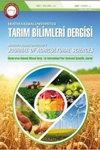产细菌素样抑制物质(BLIS)的植物乳杆菌益生菌在白卤奶酪生产中的应用
IF 1.1
4区 农林科学
Tarim Bilimleri Dergisi-journal of Agricultural Sciences
Pub Date : 2019-12-05
DOI:10.15832/ANKUTBD.423833
引用次数: 0
摘要
本研究的目的是研究一种产生细菌素样抑制物质(BLIS)的原生益生菌植物乳杆菌的抗菌活性,该菌株先前从图卢姆奶酪中分离出来,并满足作为奶酪生产辅助培养物的技术标准,在白盐奶酪生产和成熟过程中减少金黄色葡萄球菌的感染。在两项试验中,用人工污染金黄色葡萄球菌的巴氏奶制作奶酪,平均污染水平为6.243 log MPN mL-1。在发酵剂中添加1%的植物芽孢杆菌BG33。该研究还对不含辅助培养物的对照组奶酪进行了研究。采用BAM的5管MPN法对金黄色葡萄球菌计数进行长达90天的监测,并通过PCR扩增编码金黄色葡萄球菌耐热核酸酶的nuc基因400 bp片段来证实MPN法的每个阳性管(最可能数)。植物芽孢杆菌BG33在成熟第18天减少金黄色葡萄球菌数量的能力为0.9 log单位。成熟39天和59天后,与对照组奶酪相比,Lb. plantarum BG33分别降低了1.9和2.0个对数单位的金黄色葡萄球菌数量,对照组奶酪的金黄色葡萄球菌数量分别降低了0.5和1.0个对数单位。综上所述,植物芽孢杆菌BG33在白卤奶酪成熟过程中的BLIS活性可以作为白卤奶酪生产中的生物保护辅助培养物,以防止金黄色葡萄球菌的生长,金黄色葡萄球菌是一种重要的食源性致病菌,对奶酪的安全生产具有重要意义。产生抑制物质(BLIS)的植物乳杆菌,以前从图卢姆奶酪中分离出来,满足奶酪生产中的辅助培养技术标准,在白盐奶酪生产和成熟过程中减少金黄色葡萄球菌。在两项试验中,用人工污染金黄色葡萄球菌的巴氏奶制作奶酪,平均污染水平为6.243 log MPN mL-1。在发酵剂中添加1%的植物芽孢杆菌BG33。该研究还对不含辅助培养物的对照组奶酪进行了研究。采用BAM的5管MPN法对金黄色葡萄球菌计数进行长达90天的监测,并通过PCR扩增编码金黄色葡萄球菌耐热核酸酶的nuc基因400 bp片段来证实MPN法的每个阳性管(最可能数)。植物芽孢杆菌BG33在成熟第18天减少金黄色葡萄球菌数量的能力为0.9 log单位。成熟39天和59天后,与对照组奶酪相比,Lb. plantarum BG33分别降低了1.9和2.0个对数单位的金黄色葡萄球菌数量,对照组奶酪的金黄色葡萄球菌数量分别降低了0.5和1.0个对数单位。综上所述,植物芽孢杆菌BG33在白卤奶酪成熟过程中的BLIS活性可以作为白卤奶酪生产中的生物保护辅助培养物,以防止金黄色葡萄球菌的生长,金黄色葡萄球菌是一种重要的食源性致病菌,对奶酪的安全生产具有重要意义。本文章由计算机程序翻译,如有差异,请以英文原文为准。
Application of Bacteriocin-Like Inhibitory Substances (BLIS)-Producing Probiotic Strain of Lactobacillus plantarum in Control of Staphylococcus aureus in White-Brined Cheese Production
The aim of this study was to investigate the antimicrobial activity of an autochthonous probiotic strain of bacteriocin-like inhibitory substances (BLIS)-producing Lactobacillus plantarum, previously isolated from a Tulum cheese and satisfied technological criteria as adjunct culture in cheese production, in reducing Staphylococcus aureus during production and ripening of white-brined cheeses. Cheeses were manufactured in two trials from pasteurized milk artificially contaminated with S. aureus to the mean level of 6.243 log MPN mL-1. Lb. plantarum BG33 was added at 1% as adjunct to the starter culture. The study was also carried out with control group cheeses produced without the adjunct culture. S. aureus counts were monitored for up to 90 days by BAM’s 5-tube MPN method and each positive tube of MPN (most probable number) method was confirmed by PCR amplification of a 400 bp fragment of the nuc gene, which encodes the thermostable nuclease of S. aureus. The capacity of Lb. plantarum BG33 to reduce S. aureus count was found as 0.9 log unit on the 18th day of ripening. After 39 and 59 days of ripening, Lb. plantarum BG33 lowered S. aureus count by 1.9 and 2.0 log units, respectively, when compared to control group cheeses in which it was lowered by 0.5 and 1.0 log units, respectively. As a result, the BLIS activity of Lb. plantarum BG33 throughout ripening of white-brined cheese could make it useful as bioprotective adjunct culture in white-brined cheese production to prevent S. aureus growth which is an important foodborne pathogen in respect of safe cheese production. inhibitory substances (BLIS)-producing Lactobacillus plantarum, previously isolated from a Tulum cheese and satisfied technological criteria as adjunct culture in cheese production, in reducing Staphylococcus aureus during production and ripening of white-brined cheeses. Cheeses were manufactured in two trials from pasteurized milk artificially contaminated with S. aureus to the mean level of 6.243 log MPN mL-1. Lb. plantarum BG33 was added at 1% as adjunct to the starter culture. The study was also carried out with control group cheeses produced without the adjunct culture. S. aureus counts were monitored for up to 90 days by BAM’s 5-tube MPN method and each positive tube of MPN (most probable number) method was confirmed by PCR amplification of a 400 bp fragment of the nuc gene, which encodes the thermostable nuclease of S. aureus. The capacity of Lb. plantarum BG33 to reduce S. aureus count was found as 0.9 log unit on the 18th day of ripening. After 39 and 59 days of ripening, Lb. plantarum BG33 lowered S. aureus count by 1.9 and 2.0 log units, respectively, when compared to control group cheeses in which it was lowered by 0.5 and 1.0 log units, respectively. As a result, the BLIS activity of Lb. plantarum BG33 throughout ripening of white-brined cheese could make it useful as bioprotective adjunct culture in white-brined cheese production to prevent S. aureus growth which is an important foodborne pathogen in respect of safe cheese production.
求助全文
通过发布文献求助,成功后即可免费获取论文全文。
去求助
来源期刊
CiteScore
1.40
自引率
0.00%
发文量
26
期刊介绍:
Journal of Agricultural Sciences (JAS) is an international, double-blind peer-reviewed, open-access journal, published by the Faculty of Agriculture, Ankara University. The journal invites original research papers containing new insight into any aspect of Agricultural Sciences that are not published or not being considered for publication elsewhere. Preliminary, confirmatory or inconclusive research, review articles, case and local studies and works presenting taxonomy will not be published.

 求助内容:
求助内容: 应助结果提醒方式:
应助结果提醒方式:


